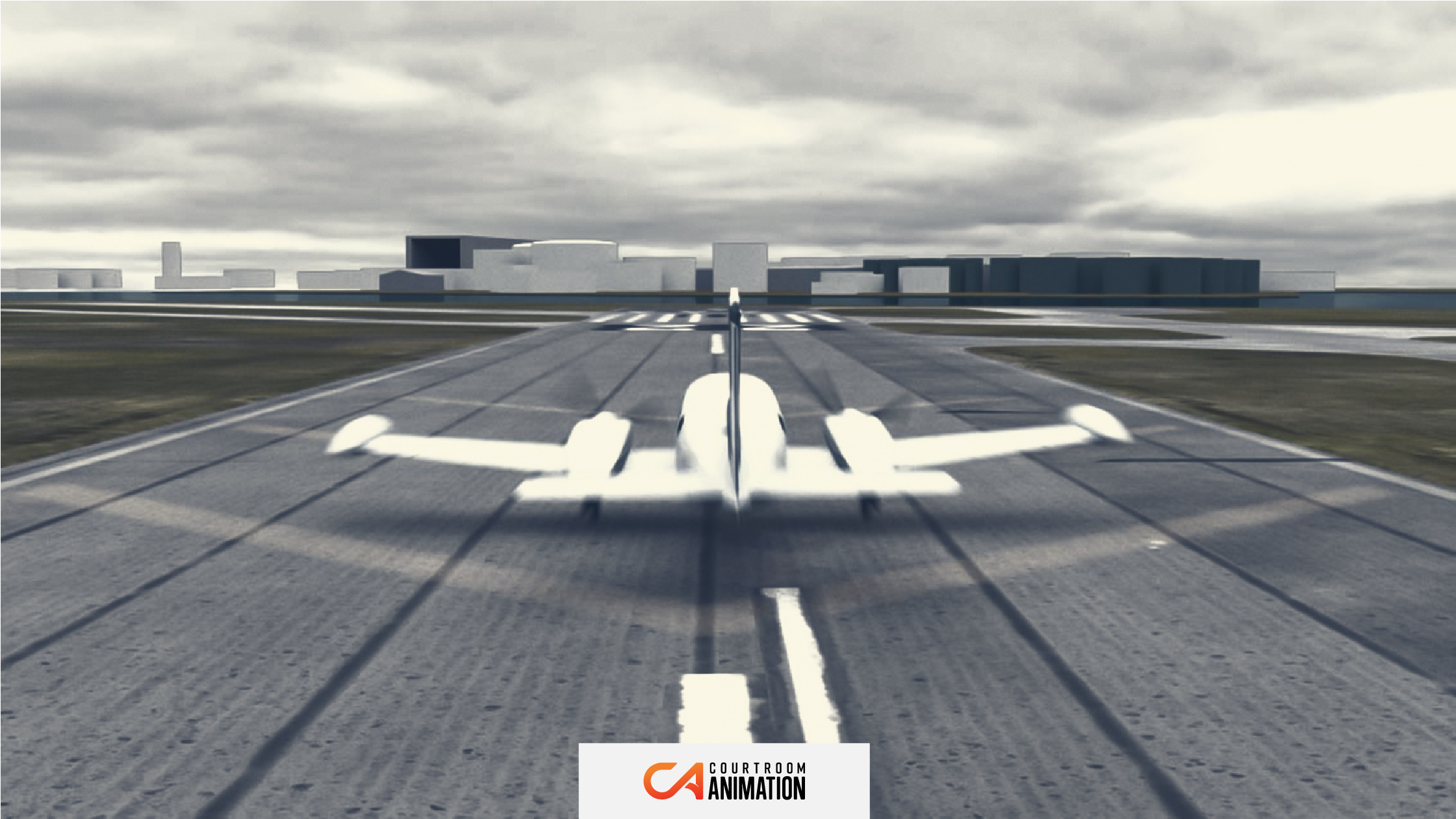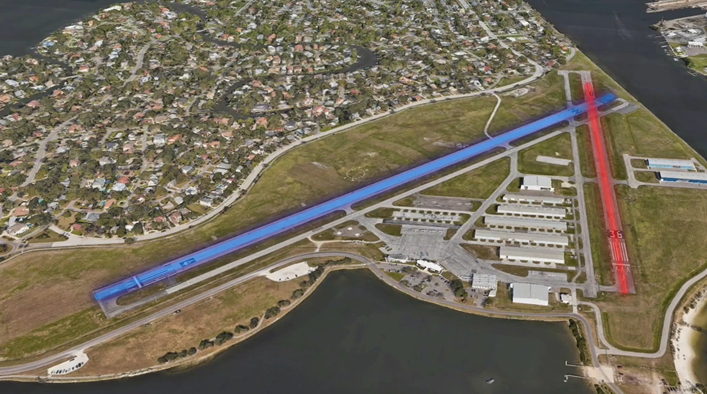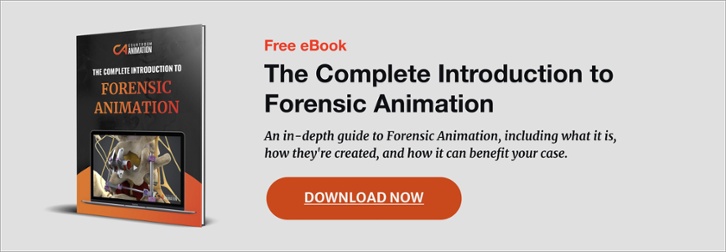
More than 90% of the 220,000 civil aircraft registered in the United States are classified as general aviation. Naturally, with all of these planes in the skies, accidents do happen. And although commercial aviation safety is at an all-time high, general aviation continues to see about 1,200 accidents per year, of which 1-in-6 are fatal. When these unfortunate incidents occur, civil litigation is called upon to settle disputes and determine liability.
The challenge for attorneys litigating these cases is that aviation accidents are almost always multifaceted and difficult to explain. There is rarely one single cause of an airplane crash: for example, an accident may be the result of some combination of weather, mechanical failure, and pilot error. And the nuances behind these factors are often complex and beyond the knowledge of the layperson who will serve on a jury.
To explain these complexities, aviation animations are one growing visual aid choice for attorneys in these types of civil cases. Whether in trial or during settlement discussions or mediation, they provide unique advantages to the party that uses them.
And while these animations have become more popular in litigation today, you might be surprised to learn that they actually have been used for many decades now, and for purposes that go beyond the legal system. So, when did the first use of aviation animation occur in litigation? How could this form of visual explain the nuances of your aviation case, and help you to achieve a favorable settlement or verdict?
In this article, we’ll answer all these questions and more. If you are considering investing in an aviation animation but want to learn more about their history and how they are used, then this blog is for you.
What is Aviation Animation?
Aviation animation is the visual output of when modern computer software is used to recreate an airplane crash or accident. It is used to explain the complex nuances of an incident, including what happened before and after. It is highly accurate, relying on a detailed forensic recreation of the scene of the incident, the airplane and its mechanical components, and even the physics involved.
This is why aviation animations are such a powerful visual litigation strategy for attorneys and other parties throughout the legal process. They support depositions or testimonies to explain mechanical failures, pilot errors (or no pilot errors), and can model weather conditions during the accident.

Aviation animations are also powerful because they can recreate crashes from pilot perspectives, birds-eye viewpoints, and countless other vantage points. They are developed from laser scan data, accident reports, and other environmental data.
Traffic accident animations are not just for cars!
Many attorneys are familiar with truck and car crash animations, since those accidents are more prevalent. But there are lesser-used versions of motor vehicle collision animations that do not include cars. These legal animations cover airplanes, sea-faring ships, and can even include spacecraft.
Wait, spacecraft? Yes, you read that correctly. In late 2021, NASA sent a spacecraft to investigate two asteroids, Dimorphos and Didymos. Eventually, the goal is to slam into Dimorphos at 15,000 miles per hour, knocking it off its orbit and away from Earth. This will be the ultimate test of their asteroid-deflecting technology. NASA continues to reach for the stars and push humans to explore the last frontier.
If humans start transitioning into space, there’s a possibility that, eventually, attorneys could start seeing more cases revolving around spaceship accidents. One day, we might even write an article titled, “The History of Spacecraft Animation in Litigation!”
While we could spend all day thinking about potential spacecraft accident reconstructions, general aviation animation has a history that warrants explaining.
Brief History of Airplane Collisions & Animations
We’re lucky to live in a time where commercial aviation is quite safe, as the last fatal crash with a major airline in the United States was Asiana Airlines Flight 214 in 2013. A documentary series, titled Mayday: Air Crash Investigation, aired an episode in 2016 that included a 3D animation of the unfortunate crash.
However, general aviation still experiences occasional crashes. The general aviation fatal accident rate has fallen in recent years, from about 1.07 fatal accidents per 100,000 flight hours in 2019, to 1.05 per 100,000 flight hours the following year. To conceptualize this data, in 2020, there were 332 total fatal injuries and 1,085 total accidents in general aviation.
First Use of Aviation Animation in Court
In 1985, Delta Flight 191 crashed into an airport in Texas. The crash resulted in 137 deaths and extensive property damage. After, the longest major aviation trial in U.S. history took place, lasting 14 months from 1988 to 1989. It involved the Federal Aviation Administration and National Weather Service. Would they be held liable for the estimated $100-200 million in wrongful death and loss of property claims?
This historic case was the pioneer of forensic computer animation in courtrooms. To help support their case, a visual exhibit explained the complex circumstances that caused the crash. The Department of Justice’s final animation’s estimated cost was, in today’s dollar value, $210,000 to $310,000, and took two years for animators to complete. The final result of the case was that the National Weather Service and air traffic controllers were absolved of all liability and negligence claims.
While the use of aviation animation in such cases is now more common, the Flight 191 animation was so unique at the time that it was featured as the ABA Journal’s December 1989 featured cover story.


Left: Still From Delta Air Lines Flight 191 Animation (1985)
Right: 3D Aviation Animation from Courtroom Animation (2021)
Since the Delta 191 crash, technology has vastly improved, allowing us to produce animations more affordably and on a much shorter timeline. Animation has become routinely used in not only commercial aviation cases, but general aviation cases as well.
Modern Use-Case of Aviation Animation in Litigation
One attorney leveraged an aviation animation to explain the complexities of an aviation crash in Florida. In this case, two aircraft narrowly missed a collision. One pilot, during his evasive maneuver to avoid striking the other airplane, could not regain control, and unfortunately lost his life.
Learn how much an aviation animation costs by downloading our free Pricing Guide!
Surveillance footage taken from airport cameras captured the two aircraft leaving the runway at the same time. This data was used to accurately re-create the airport’s environment and the incident itself. The pilots’ viewpoints, the configuration of the runways, and the proximity of the planes before and during takeoff were important for accurately evaluating liability.

Aviation animation is always based on multiple pieces of real data — such as using video surveillance to recreate the environment of the crash and analyzing it. These forensic animations equip attorneys with the power to extract a tremendous amount of information from a timeless visual.
“Leveraging surveillance footage from a single camera near the airport, we were able to recreate the entire incident. The most powerful perspective we used in the trial was that of my client – a pilot’s point of view showing the evasive maneuver to avoid an oncoming aircraft.”
– Michael Siboni, Attorney at Siboni & Buchannon, PLLC
Aviation Animations Help Your Case Take Off
Unlike commercial aviation, general aviation experiences aircraft crashes fairly frequently. Due to the complex nature of those cases, a forensic animation is one of the optimal visual approaches for attorneys.
This type of visual aid has become increasingly mainstream since the famous 1985 Delta Flight 191 trial animation. Now, modern 3D aircraft accident reconstructions are based on physical data, surveillance footage, photos of the site, expert data, laser scan data, and other measurements to ensure accuracy and admissibility. They are generally more affordable and created at a faster pace than in the late 1900s.
While you may have a deep understanding of how aircraft work, the average juror most likely does not. Aviation animations are a proven tool to help strengthen an attorney’s case to reach a more favorable settlement or verdict. For example, one legal animation can help viewers absorb complex ideas quickly and recall them at future dates.
Interested in learning more about general aviation animation, or have a specific question?
Our team of animators have years of experience creating aviation accident reconstructions. Our visuals have a 99% chance of admissibility, and we would love to discuss your aviation case. Get a free quote and collaborate with an animation expert today!
